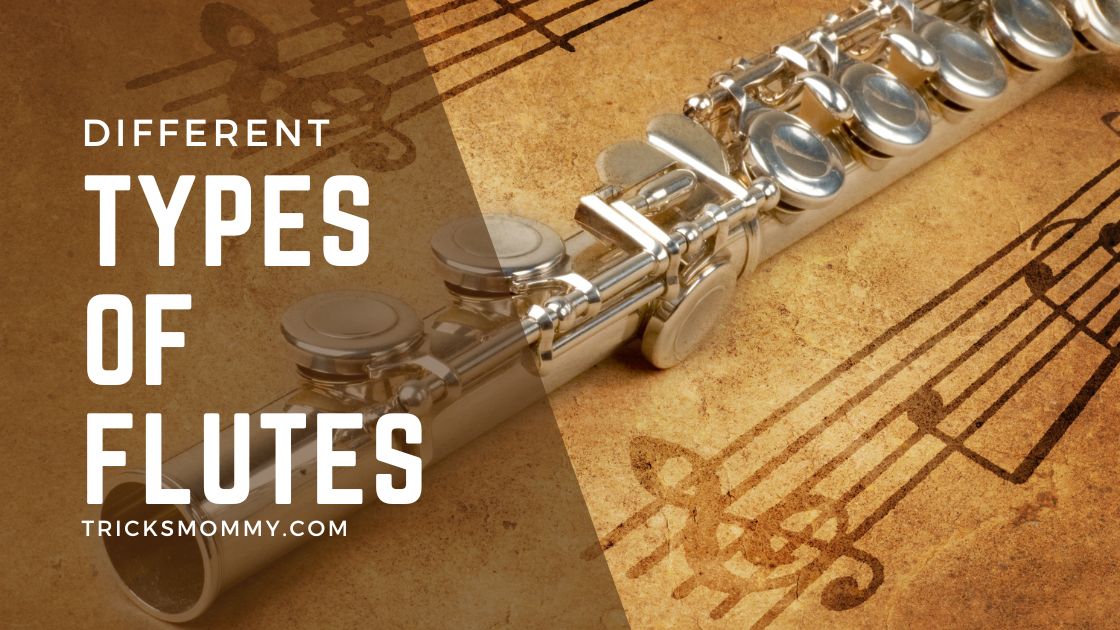Do you know there are different Types of Flutes? Are you a flute enthusiast and are perhaps thinking about getting yourself or your kid a flute? Then you may want to learn a bit more about this fascinating musical instrument. Flutes are simple instruments that have been around for centuries, but before making any investments, get to know different types of flutes.
A flute can come in many different sizes, shapes, and types, but they all have one thing in common; the rich and graceful sound they produce. These are played by holding it with both fingers while blowing across the hole. So if you wish to expand your musical skills, this instrument is an attractive choice.
If you consider yourself a flutist in the making, to help you in the right direction, find below everything you need to know about different flutes, which is the best for beginners, their history, and more interesting facts about flutes.
Types of Flutes
Bamboo Flute for Beginners
The body is made of Bitter bamboo. Dried for two years, the bamboo pattern is fine and straight. The flute is flat and smooth without cracks.
The joint is made of high polished brass. Head and tail are made of synthetic horns. The voice is melodious and euphemistic, and the tunes played are beautiful, delicate, and gorgeous.
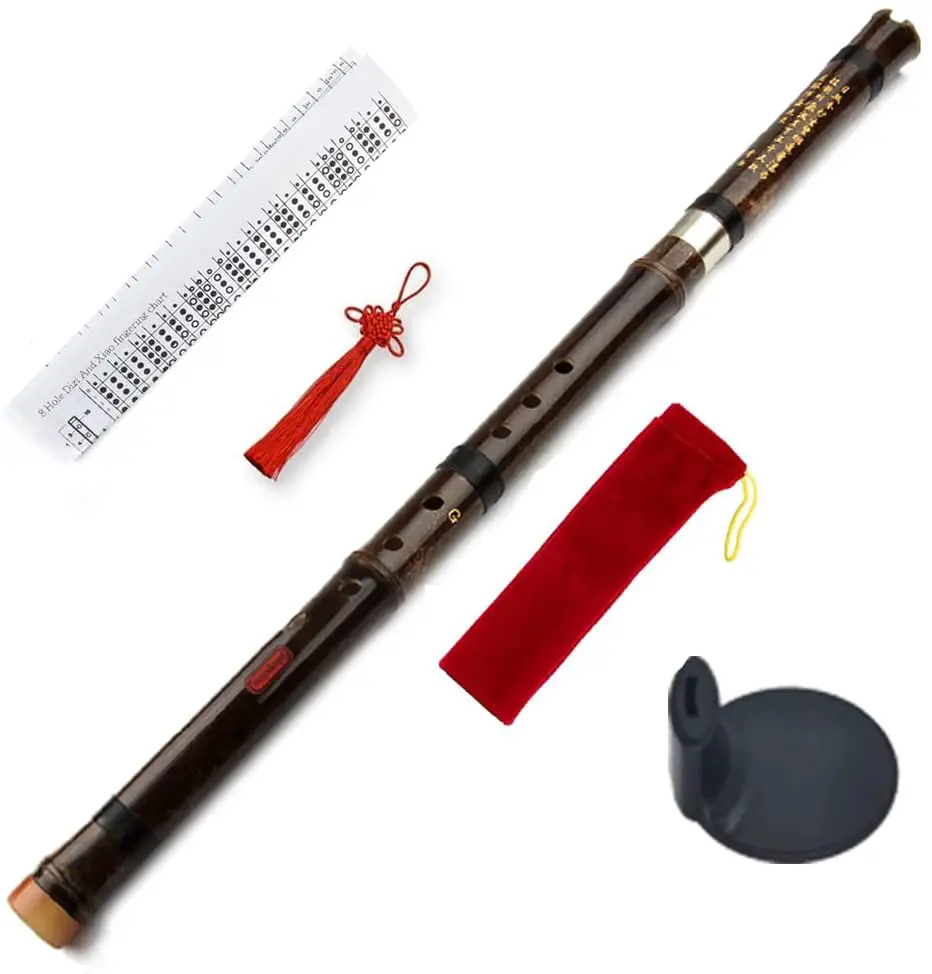
Features:
- Bamboo
- 75 Grams
- Professional Dizi box
Nickel Plated Closed Hole C Flute
This kit includes our Mendini flutes with a closed hole C flute and offset G key & split E key has 16 keys altogether.
The flute features a flawless finish, closed hole, undercut beveled embouchure with high-quality double bladder pads.
It comes with a durable case, joint grease, cleaning cloth and rod, as well as a pair of gloves.
The metal flute set also includes a foldable stand to hold the instrument and a pocketbook with basic technique instructions like holding the flute, maintaining it, and other guidance.
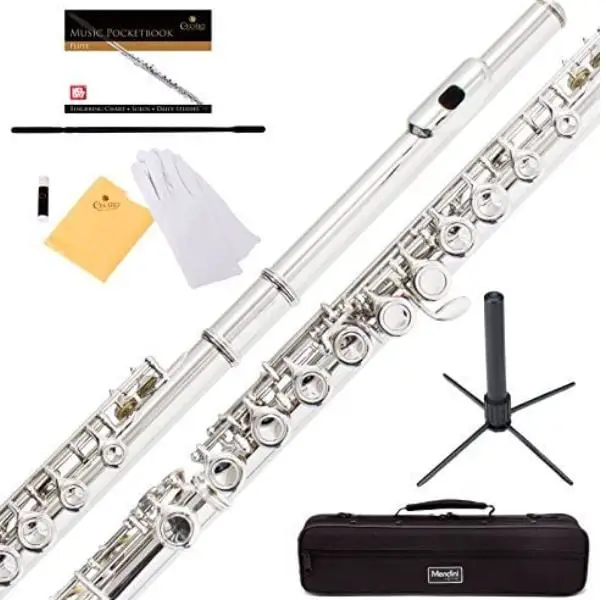
Features:
- Metal
- 2 Pounds
- Elegant Design
Irish Professional Rosewood D Flute
This professional flute is made of quality rosewood. It is fully playable, and it can be adjusted in four different parts. Comes with an excellent natural finish.
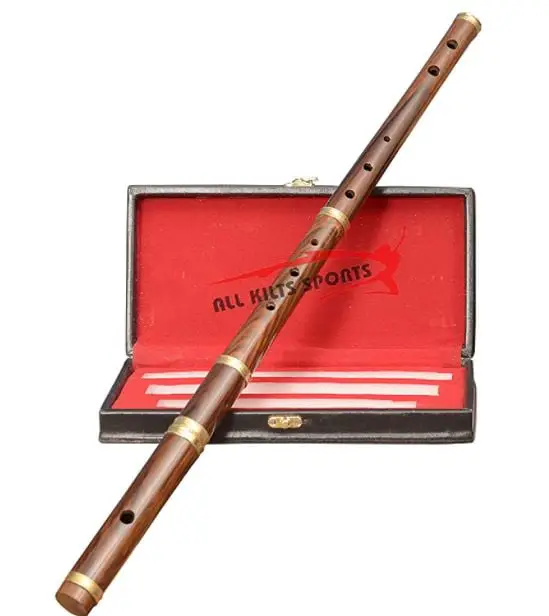
Features:
- Quality rosewood
- Adjustable
- Natural Finish
Concert Band Flute
This Cupronickel C 16 Closed Holes Concert Band Flute is made of high-quality cupronickel material, with a beautiful appearance and firm structure.
It features a C tone and 16 closed holes. What is more, beautiful and stylish design makes it appealing to customers.
Due to its exquisite craftsmanship and mature technology, this flute emits melodious sound. Additionally, it can be used in many fields, such as private lessons, concert band, orchestra, etc.
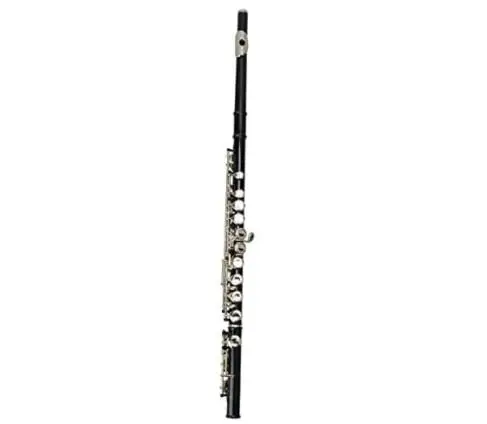
Features:
- Cupronickel
- C tone
- 16 closed holes
Mendini Silver Plated Key of C Piccolo Flute
This flute features a flawless finish, undercut beveled embouchure, high-quality double bladder pads, and an ergonomic finger brace.
This piccolo package includes a deluxe plush-lined durable hardshell case, a soft cleaning cloth, a cleaning rod, joint grease, and a pair of white gloves.
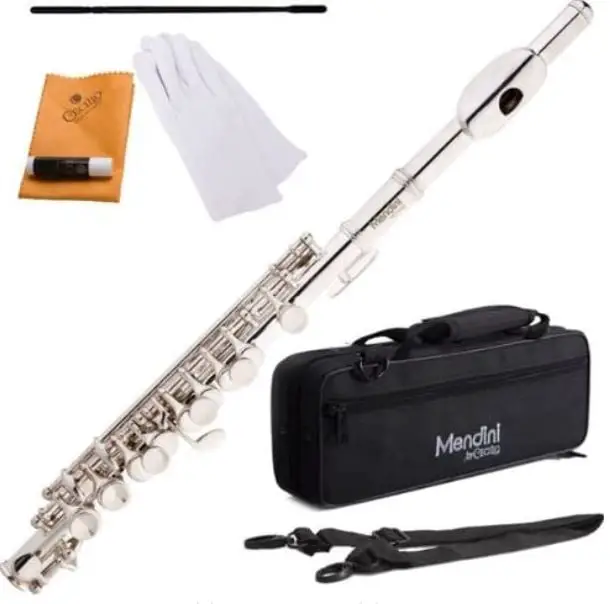
Features:
- Silver-plated
- Key of C
- Closed Hole
Brief Flute History
Flutes are one of the earliest known instruments, with flutes dating back to the ancient Stone Age period.
In military and folk music, simple wooden flutes with six holes were used throughout the Middle Ages and Renaissance periods. However, their problematic intonation and complicated cross fingerings meant they were not heavily featured in musical works. Flute makers up until the 19th century tinkered with flute design and construction.
However, a goldsmith and musician called Theobald Boehm revolutionized flute design from the early 1800s. The flutes we play today are based on the Boehm model. Only slight changes have been made during the 19th and 20th centuries.
What are the four main types of western concert flutes?
Concert Flute
A concert flute (also called a C flute) is an edge-tone instrument that has gained enormous popularity in western cultures.
As its name implies, the C flute features the C key, and although most flutes are played vertically, the C flute is played horizontally.
Piccolo
It consists of two parts instead of three; the head joint with the mouth hole and the middle joint with the holes and the key work. The piccolo became an integral part of the romantic orchestra after Beethoven gave it a prominent passage in his Sixth and Ninth symphony.
The piccolo has a very high range, which is why it also has its origins in military music.
Alto Flute
The alto flute is the only commonly played flute that isn’t in the key of C but is in the key of G. The sound produced by an alto flute is relatively lower than a concert flute, which means a D on an alto flute is going to sound like an A on a concert flute.
Bass Flute
In terms of design, you will find most bass flutes quite similar to each other—with silver-plated bodies and J-shaped head joints. However, some of the older forms of bass flutes also feature an S-shaped bend in the neck. The bass flute gives out a very earthy sound, which will enhance the depth of the music.
What are other known types of flutes?
Native American Flute
These flutes are made out of tree branches and milled lumber. Native American flutes do not have separate head, foot, and body components. Instead, these flutes come as a single unit and have open holes for the player to put their fingers on. The sound produced by Native American flutes is known as “the warble” because these flutes produce a constantly changing pitch.
Bansuri
The Bansuri or Indian Bamboo Flute has one blowing hole alongside six finger holes, and it is not composed of separate components for the head and the foot piece. The bansuri is used both in concerts and solo performances, and it provides a soft yet heroic sound.
Irish Flute
Almost all Irish flutes are made out of wood, and there are three main components of the flute. These components include the head joint, body, and foot joint.
They are available in the range of D, and most players use them to produce high-pitched sounds.
Japanese Flute
Also known as the Fue flute. Unlike most flutes, the Fue is not limited to a single kind of flute. In fact, a wide range of flutes falls under the Fue category, including shakuhachi, hichiriki, hotchiku, komabue, and many more.
Korean Flute
The daegeum is a large bamboo flute that was introduced back in the 7th century. Typically, the daegeum has six finger holes on the body and one blowing hole on the headpiece. However, it does not feature separate components. Apart from the holes we mentioned above, you will also find another hole on the body where the cheong is applied.
Dizi Flute
Dizi is commonly used in Chinese traditional music; the dizi is made out of bamboo. It doesn’t have a separate mouthpiece, head joint, and foot joint components, and it comes as a single unit. Typically, a dizi features six finger holes that a player covers with their fingers to produce different notes.
Features to Look for in Some Types Flutes
There are a few features to look for when purchasing a flute. The first is the type of flute. There are three main types of flutes: the transverse (or European) flute, the recorder, and the Native American flute. The transverse flute is the most common type and has a cylindrical bore. The recorder is a type of flute that has a conical bore and is held vertically when played. The Native American flute is a type of flute that has a simple, open-ended design and can be either end-blown or side-blown.
The next thing to consider is the material the flute is made of. The most common materials are wood, metal, and plastic. Each material has its own unique sound. Wood flutes have a warm sound, while metal flutes have a brighter sound. Plastic flutes are the least expensive option and are a good choice for beginners.
Finally, you’ll want to consider the size of the flute. Flutes come in a variety of sizes, from soprano to bass. The size of the flute will affect the pitch of the notes that it plays. Soprano flutes have a higher pitch, while bass flutes have a lower pitch.
When purchasing a flute, it’s important to consider these three factors: the type of flute, the material it’s made of, and the size. With so many options available, you’re sure to find the perfect flute for you.
What are the benefits of Choosing the Right Type of Flute
The benefits of choosing the right type of flute are many. The most obvious benefit is that you will be able to play the instrument correctly and produce the desired sound. If you choose the wrong type of flute, it will be difficult or impossible to play the instrument correctly and you will not be able to produce the desired sound.
Another benefit of choosing the right flute type is that you can play the instrument with more ease and less effort. The wrong type of flute will require more air to produce the desired sound and will be more difficult to control. Finally, choosing the right type of flute will help you avoid problems such as neck pain or other physical problems that can occur from playing the wrong type of flute.
So, when choosing a flute, be sure to consider the benefits of choosing the right type of flute. It will make a world of difference in your playing and in your enjoyment of the instrument. Happy fluting!
How to Choose Types of Flutes
There are a few different types of flutes that you can choose from. The decision of which type to choose depends on your experience, skill level, and budget.
The first type of flute is the wooden flute. This type of flute is typically the cheapest option and is best for beginner musicians. It is made from wood, which gives it a mellower sound than the other types of flutes.
The second type of flute is the metal flute. This type of flute is more expensive than the wooden flute, but it produces a brighter sound. It is also easier to play in tune with other instruments. Metal flutes are best for intermediate to advanced musicians.
The third type of flute is the plastic flute. This type of flute is the most expensive, but it is also the easiest to play. It produces a very bright sound and is durable, making it a good choice for beginner to intermediate musicians.
No matter what your skill level or budget is, there is a type of flute that is right for you. Do some research to figure out which type of flute will work best for you and your needs. You’ll be playing beautiful music in no time!
Flutes come in all different shapes, sizes, and colors. They can be made from wood, metal, or plastic. Each type of flute has its own unique sound.
When choosing a flute, you should first consider your skill level and budget. If you’re a beginner musician, you’ll probably want to choose a wooden or plastic flute. These types of flutes are typically the cheapest options. Wooden flutes have a mellower sound, while plastic flutes are easier to play and produce a very bright sound.
If you’re an intermediate to advanced musician, you’ll probably want to choose a metal flute. Metal flutes are more expensive than wooden or plastic flutes, but they’re also easier to play in tune with other instruments. Plus, they have a brighter sound.
No matter your skill level or budget, there’s a flute out there that’s perfect for you. Do some research to figure out which type of flute will work best for you and your needs. You’ll be playing beautiful music in no time!
Flutes come in all different shapes, sizes, and colors. They can be made from wood, metal, or plastic. Each type of flute has its own unique sound.
Common Questions About Types of Flutes
What is a flute instrument?
The flute is a beautiful sounding instrument that is a woodwind instrument. Most woodwind instruments include reeds, but the flute is different. It is known as a reedless wind instrument as it produces its sound when you blow across the opening, and then the flow of air oscillates, creating the sound.
How is the flute played?
It is played by being held sideways, holding the flute with both hands, and blowing across the hole. The pitch is altered by using your fingers to open and close the keys/holes.
What is a long flute called?
The concert flute is the longest flute family you should know. It comes in 26 inches in length, and it’s pitched in the key of C.
What is the smallest flute?
The piccolo is the smallest flute you can encounter available.
What is the biggest flute called?
The biggest flute is the double contrabass flute. It’s also called the octobass. It comprises metal. That’s why it’s bigger than hyper bass despite having the lowest pitch. This huge instrument measures 8 feet tall and has a tubing of up to 22 feet as it weighs about 30 pounds.
What flute is mostly used for beginners?
The plastic flute is great and allows younger children to get involved and learn this great instrument. It’s suitable for all levels, although most commonly used for beginners due to its “first note” mouthpiece. This allows the player to get a good sound when they first play.
The interchangeable parts mean the instrument can be used at different levels- from beginner to advanced. Meaning it’s adaptable and can last a bit longer as the player improves.
What are the 3 main flutes?
There are three main types of flutes: transverse (or side-blown), recorder and Native American flutes. The transverse flute is the most common, followed by the recorder and then the Native American flute.
What is a transverse flute?
A transverse flute is a flute that is held horizontally, with the mouthpiece at one end and the open end pointing away from the player. The player blows across the hole in the mouthpiece to create sound. Transverse flutes are also known as side-blown flutes.
What is a recorder?
A recorder is a flute that is held vertically, with the mouthpiece at the top and the open end pointing downwards. The player blows into the mouthpiece to create sound. Recorders come in different sizes, with sopranino, soprano, alto, tenor and bass being the most common.
What is a Native American flute?
A Native American flute is a flute that is held vertically, with the mouthpiece at the top and the open end pointing downwards. The player blows into the hole in the side of the flute to create sound. Native American flutes come in different sizes and can have either two or six holes.
What are the differences between the three types of flutes?
The main difference between the three types of flutes is the way they are held and how the player creates sound. Transverse flutes are held horizontally and the player blows across the hole in the mouthpiece. Recorders are held vertically and the
What is the most common type of flute?
The most common type of flute is the transverse flute.
What is the wooden flute called?
The wooden flute is called a transverse flute.
What is a long flute called?
A long flute is called a euphonium.
How much do flutes cost?
Flutes can cost anywhere from a few dollars to several thousand dollars. The price depends on the type of flute, the materials used to make it, and the level of craftsmanship. beginner’s model might only set you back $10-20, while a professional-level flute could cost upwards of $3,000.
How much is an expensive flute?
An expensive flute can cost anywhere from $100 to $10,000 or more. The most expensive flutes are made of gold or platinum and may have jewels embedded in them. Some of the most rare and valuable flutes are antique instruments that were made centuries ago.
How much is a flute for a beginner?
A good beginner flute can range from around $80-$200. You can often find deals on beginner flutes if you shop around online or in person.
We thought you also be interested in learning the 5 steps of how to clean a flute.

